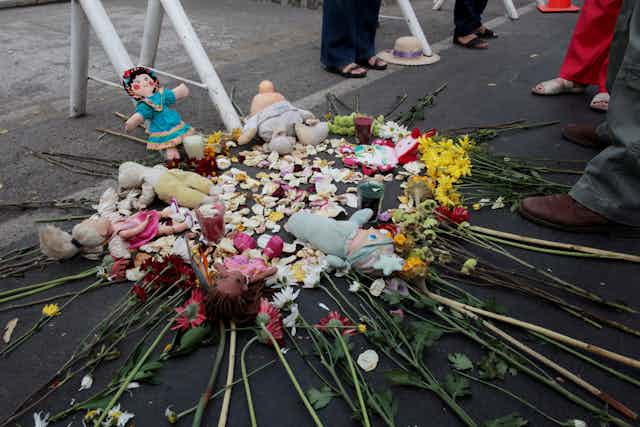On the morning of March 8 2017, while women around the world were preparing to observe International Women’s Day with a global strike, 43 girls burned to death in a shelter in San José Pinula, Guatemala.
The Hogar Seguro Virgen de la Asunción, located on a hillside 15 kilometres from Guatemala’s capital, housed some 800 girls and boys who’d been abused or neglected in their homes, as well as young offenders of both genders. For months, the girls’ wing had complained about systematic rape and sexual abuse as well as overcrowding, disappearances, murder and generally bad conditions.
The scandal had been exposed in November 2016 by the investigative reporting outfit Plaza Pública and the home was under investigation. Reporter José David López Vicente wrote that while the shelter is “in theory a state centre for the protection of children and adolescents…in reality it is an inferno where people rape and mistreat those they should protect.”
Residents chose International Women’s Day to demand a safe and decent home. By the end of the protest, the girls had set fire to mattresses and furniture in the dormitories. And, survivors say, instead of freeing them from the flames and entering discussions, shelter officials locked the girls in their room, where dozens perished.
Who’s to blame?
“Fue el estado”, citizens cried, blaming the government for the girls’ deaths. And they’re right. Of course, it was the state.
But as Guatemalan activist Leslie Lemus recently opined, a general assertion of guilt is not enough: those responsible must be brought to justice.
Three civil servants of the Guatemalan social well-being department – secretary Carlos Rodas, deputy secretary Anahi Keller and shelter director Santos Torres – have been arrested. But society must also hold legally responsible Guatemala’s president, Jimmy Morales, because there is a chain of command here that can be traced all the way up to the executive.
Beyond criminal justice, it is also important to place the girls’ sexual exploitation and murder within the broader context of Central American feminicide and generalised violence.

These are related phenomena. Guatemala has an alarmingly high rate of feminicide, that is, the killing of women based on their social or biological gender. From 2000 to 2012 over 6,000 women were murdered, and according to the Global Burden of Armed Violence report, Guatemala ranked first in female homicides committed with firearms from 2007 to 2012.
Gender-based violence has been increasing in Guatemala since 2013, together with sexual abuse. And the combined threat to women is forcing them to flee the country.
The Hogar Seguro deaths also occurs in the context of the lethal gang and criminal violence impacting Central America’s Northern Triangle regon, not to mention a history of political violence, civil wars and drug trafficking-related violence that has always targeted women.
The girls’ deaths then were not accidental. They form part of a trend in Central America and Mexico, in which women’s bodies are routinely used, exploited, destroyed, possessed, profited from and violently appropriated.
A necropolitical war
The murders support an idea developed as part of my research on the causes of and social impacts of drug violence. The “necropolitical war” is a conflict typology that explains criminal and sexual violence as part of a continuum that may include torture, forced disappearance, and sex trafficking. It aims to dominate populations and secure criminal markets, in part by commodifying women’s bodies.
The frequent assassinations of Latin American environmental activists are part of this strategy, too. Drug traffickers, gang members and security guards, among other armed actors, sell their killing expertise to repressive governments to help secure the domestic business interests of transnational corporations.
In Central America and Mexico’s regime of widespread corruption and impunity, anyone is vulnerable to violence and death. Necropolitics, though, particularly impacts society’s most marginalised – not only indigenous activists and but also, quite explicitly, women and girls.
At least two necropolitical wars are currently underway in Central America. The first is that waged by cartels to obtain state “partnership” – that is, to gain privileged, protected access to trafficking routes and other critical business resources.
Mexico’s Sinaloa Cartel obtained this elite status during the fiercest years of the country’s war on drugs. From 2006 to 2012, it was not the target of military operations in the same way as other cartels.
The second war seeks to dispossess women of their bodies. Dispossession in the Marxist sense means taking away one individual’s possessions for another to accumulate capital. In the 19th century, workers’ most valued possession was their labour, as socialist theorists well knew.
Central America’s poor, rural and unemployed women often do not even have that: they have only their bodies to offer. That’s actually a valuable commodity, both in Central America’s highly machista society and in the sex trade.
But bodies can cease to be valuable to the people who hold power. They get old, are unattractive or, in the case of women who refuse to be subjugated, far too rebellious to be worthwhile. Then, they become disposable.

In those cases, women begin to run serious risks. Hence, the violent end met by 43 Guatemalan girls, aged 12 to 17, who, after refusing to be raped and exploited any longer, were burned to death.
While these two necropolitial conflicts have different aims, they share a common feature: a dysfunctional, permanently corrupt and deadly legal-spatial realm in which impunity secures their main strategies – massacre, feminicide and forced disappearances.
This machinery gives the agents of war control over drug markets and the sex trade of women and girls in their thrall, subordinating women’s rights and bodily integrity to the economy.
In Mexico, where criminal violence is part of a dangerous combination that serves to “cleanse” communities of people who defend their home territory, this dynamic is clear.
Guatemala’s shelter fire exposes the same malignant logic. Testimonies and reports indicate that the girls were systematically exploited for many years. Then, on International Women’s Day 2017, they finally fought back, and were summarily disappeared.

